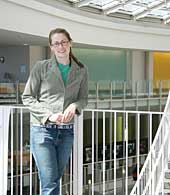|
Today's
Graduates Look to Fill the 'Gap'

Emily Taylor ’08, president of the Student Government
Association, will spend her career 'gap' with Teach for
America. |
After being in
school nearly their whole lives, participating in clubs and
sports teams and volunteering for good causes in their spare
time, seniors are now facing the unknown of what to do after
graduation.
Increasingly, say officials,
today’s college graduates
are staving off a long-term plan and filling the immediate
void with a short-term option.
“For most college students, the next step has always
been evident. The end of college marks the first time in
which the next step is absolutely unclear,” says Stacie
Hagenbaugh, director of the Smith College Career Development
Office (CDO). “ ‘Gap opportunities’—ones
like Teach for America and AmeriCorps—hold great interest
for students who are overwhelmed by that.”
Statistics reflect that. Teach
for America, for example, reported increases in applications
each of the past few years. Nationwide,
the number of applicants grew from 18,500 graduates in 2007
to 24,714 in 2008, according to Kerri Keafer, a Teach for
America recruiter.
At Smith, the number of applicants
to the national corps of graduates who teach in low-income
communities jumped from 34 to 47. Smith's acceptance rate
to the highly selective program is consistently more than
twice the national average.
Hagenbaugh attributes
some of the increase in popularity of “gap opportunities” to
their ability to buy time for students to decide their
next step. Making a commitment to a few years of service
gives graduates a window of time to thoughtfully consider
what to do next while serving in a role they consider worthwhile.
“It is a great thing for college graduates who don’t
want to look past two years,” agrees Emily Taylor ’08,
who will soon receive her bachelor’s degree in government,
with a minor in environmental science.
Taylor, the current Student
Government Association (SGA) president, follows Megan Ambrus ’07,
the previous SGA president, by enlisting in Teach for America.
Ambrus is finishing her first year in a Connecticut school
system; Taylor has been assigned to teach in San Francisco,
Calif.
Taylor was attracted to
the program because she wants to “pay
back” the good fortune from which she benefited, she
said. It will also allow her to forgo graduate school applications
for a few years while not hindering any future possibilities. “It
opens a lot of doors and doesn’t close off any,” she
says.
Current applicants seem
less and less worried that they will be sidetracked from
their career goals if they volunteer—one
of the main concerns vocalized in the past, notes Teach for
America’s campus representative Emily Schoch ’08.
“Over the past few years people have been more open
to the idea of Teach for America,” says Schoch, as
an alternative to “jumping into a low-level position.”
Teach for America’s
partnerships with businesses and graduate schools benefit
graduates who are considering any future paths, she adds.
The organization touts its agreements with potential employers
such as Citigroup and Goldman Sachs, General Electric and
Google, and with graduate schools such as Harvard, Stanford
and Yale universities.
Taylor seems in no rush to jump to any decision about her
future beyond graduation. Eventually, she may enroll in graduate
school to further her study of science and pursue environmental
public policy, she says.
But, “there is no rush,” she adds. “I’m
22 and I have years ahead of me—plenty of time.”
|























